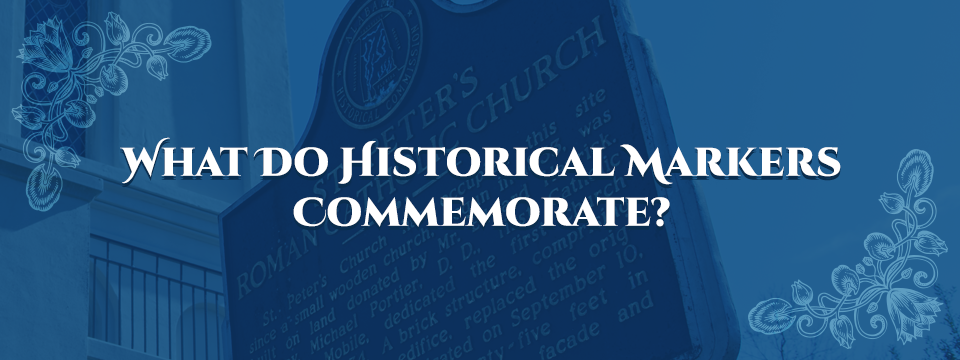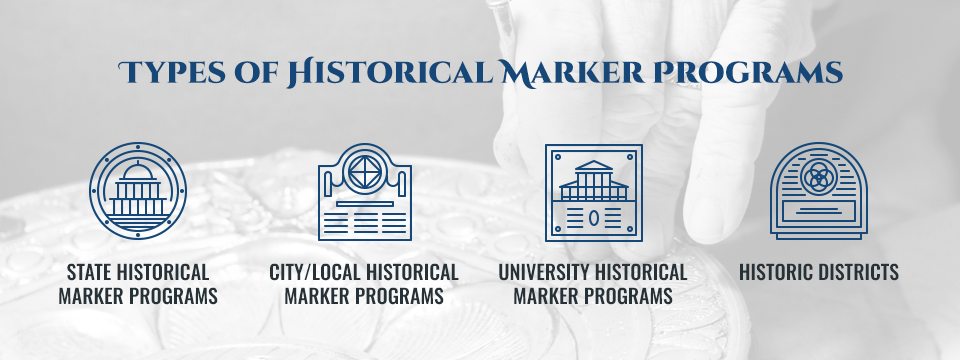All About US Historical Markers
Historical markers are one of the most iconic parts of an educational family road trip. You can see them placed throughout major highways and at popular tourist spots. Some families even drive around for the sole purpose of finding these jewels of information. Even when a vacation doesn’t focus on history, many folks still use them as stops between Point A and Point B. Needless to say, historical markers act as a crucial element of American travel.
But have you ever wondered why we have historical markers in the first place? How did we decide to create them, and how do we benefit from them today? In this guide, you’ll learn about the following topics:
- How historical markers came to be in the United States
- The intended purpose of historical markers
- The four main types of historical markers
- How historical markers impact the people who own them (and how you can take advantage of those effects, too)
How England Started the Phenomenon
While we consider historical plaques a staple of American journeys, we didn’t invent the idea. In fact, England cut us to the chase. Member of Parliament William Ewart proposed the first-ever commemorative marker program in 1863. The Society of Arts picked up the idea in 1867, putting up two plaques in London honoring Lord Byron and Napoleon III. When the 1900s came around, the London County Council adopted the program and created official selection criteria.
The London County Council was abolished in 1965, but by then they had left a legacy of over 250 blue plaques located throughout the city. But, this isn’t the end of the markers’ story. The Greater London Council oversaw historical markers from 1966 to 1985. Now, the official London Plaques company handles their creation with oversight from the government.
…And How the United States Joined in on the Fun
Three years after England started to consider historical markers, the United States government officially preserved their first historic area in 1889. During the coming years, prominent veterans’ organizations rallied for the government to do the same with well-known historic battlefields. Academics also urged the United States to protect archeological sites and the artifacts within. These movements influenced President Theodore Roosevelt to sign the Antiquities Act in 1906. The Antiquities Act authorized the President to name historic landmarks, structures and objects as national monuments.
President Woodrow Wilson established the National Park Service as a part of the Department of the Interior in 1916. The Service declared one of their primary purposes as conserving the historic elements of the parks and monuments they managed. This new organization wanted to preserve history and grow as a department. So they lobbied for sites controlled by the Agriculture and War departments. Almost two decades after the National Park Service started, they succeeded in having the Historic Sites Act passed. In 1935, this act established a policy to sanction historic locations and objects as objects of national importance. The National Park Service first issued bronze plaques for historical landmarks in 1960.
On the state level, states like Virginia started their historical marker programs as early as the first third of the 20th century. Pennsylvania, Colorado and Indiana had markers even before the start of Virginia’s program in 1926. Other states began programs a few decades later when roadside historical markers became popular. Whether designated by the federal government or state, historical markers give places of significance the recognition they deserve.
What Do Historical Markers Commemorate?
We usually think of places when we hear about historical markers, but these plaques can also help us remember people and events. When a marker does commemorate a location, either the state or National Park Service oversees its registration. Meanwhile, only states handle people and events. State governments determine the appearance of state historical markers. Meanwhile, National Register plaques come in bronze or aluminum. So, if you see the state’s designated marker appearance, you could learn about a person, place or an event. But, a National Park Service plaque marks a location since it doesn’t commemorate people or events.
When a marker describes a person, that person has a great significance to the area. They can appear near the historical figure’s home, a statue of the person or a location where the person did something important. Consider these examples:
- In Selma, Ala., the I Had A Dream marker pays tribute to Dr. Martin Luther King, Jr., and the activists in the Civil Rights movement. You can find it at the church where he led the famous 50-mile march to Montgomery.
- The General Andrew Jackson marker in Daphne, Ala., honors the place where he spoke to his soldiers during the War of 1812.
Location markers highlight historic places recognized by the National Register or the state. These plaques memorialize buildings, sites, structures, districts and objects. You can find markers at locations like:
- The White House, where you can find multiple historic markers explaining its history and significance. While some of them are behind barriers, they are all within reading distance for most people.
- The Alamo, where a marker tells the story of the Battle of the Alamo in English and Spanish. You only have to walk across the street from the iconic fort to see it.
You can usually find a historical event marker at the place where the event happened. They honor major happenings in U.S. history or the local area, such as:
- The Battle of Gettysburg, which has a marker located at East Cemetery Hill. At this location, Union soldiers pushed Confederate soldiers out of their land.
- The Pearl Harbor attack, which we remember with multiple markers at the original site. These plaques establish the naval base as a national landmark and memorialize the soldiers who lost their lives during the event.
As you can see, we use historical plaques to tell stories about essential parts of our past. They make history feel more real by taking us to those points in time in the area where it happened.
Types of Historical Marker Programs
In addition to markers created by the National Register, you can find plaques designated by states, municipalities and universities. Just like the original blue plaques in London, these markers are overseen and made on a smaller scale than national markers. These are the most common types of historical marker programs:
- State Historical Marker Programs: After World War II, historical tourism boomed. In the 1950s and 1960s, families would go on trips seeking out roadside historical markers and sites of interest. In response to the increasing number of Americans going on heritage tours, many states started or expanded their historical marker programs. State residents serve as a vital component of these marker programs. Both Pennsylvania and Texas allow citizens to nominate new historical markers every year. You can find over 2,000 plaques throughout Pennsylvania, and Texas recognizes more than 3,678 historic landmarks. Residents propose, maintain and visit these historical markers to show their state pride and learn something new.
- City/Local Historical Marker Programs: City historical marker programs work a lot like state programs except on a smaller scale. Residents and organizations nominate, sponsor and maintain plaques and markers that recognize a historically important part of the city. The Nashville metro area has 215 markers throughout the county and takes applications on an ongoing basis. In Winston-Salem, N.C., the city government opens up applications during a certain part of the year, then accepts two to three new monuments every May. Municipal governments can adjust a marker program to fit their needs and resources.
- University Historical Marker Programs: Universities can decide how historical plaques appear on their campuses. Many established colleges in the United States have been around for years, so they can tell us plenty about the past through historic buildings and monuments. Even when a university has a more recent founding date, a lot of colleges want to remember important events in the school’s history. You can find university markers in all sorts of places on campus, such as benches, buildings and trees. The school decides who manages their marker program. While the University of Arkansas has a dedicated committee, alumni and the Office of Strategic Communications work together to establish Penn State’s markers.
- Historic Districts: Historic districts have both local and national authorities maintaining them. The National Register determines what counts as a historic district, but applying for recognition involves state and federal employees. Under the register’s categories, a district consists of multiple locations in the same area that share historical significance. If you or a neighbor thinks your area could qualify, you have to get in touch with your state’s Historic Preservation Officier. After reviewing your application and neighborhood, they will work with the National Register to make things official.
If you think something in your area should be honored with a historical marker, look over this list carefully to figure out who to contact. Before consulting your state’s program, see if your county or city manages their plaques. You should also consider whether the subject of nomination has other historically significant objects and places near it. Instead of petitioning a landmark, you could nominate an entire district! Just make sure to consult anyone who lives in that area before taking the next step.
The Impacts of a Historical Marker Program
Why are historical markers important, and how do we benefit from them? In addition to honoring our past, we get many material and immaterial perks from having historical plaques. When we commemorate where history happened, the entire community grows stronger. Historical markers boost the surrounding area by enhancing the following parts of a town:
- Education: Placing a historical marker brings attention to places and events that your community members might not know about otherwise. Creating an official historic location can even give local schools an opportunity for a field trip that enhances student learning. Visitors can learn more about the area when you can show them what parts of your community history you value. History gives us context for current events and helps us understand what to do in the future. By establishing a new source of knowledge in your area, learners of all ages can develop an important connection to your monument.
- Tourism: Cultural and heritage tourism has a global value of over one billion dollars. Tourists who visit your area for historical or cultural reasons tend to not only stay longer, but they also spend more money. If your community doesn’t have a big tourism market, you can use heritage tourism as a source of wealth and outside visitors. As a bonus, the engagement associated with cultural attractions makes it easier for tourists to enjoy and remember their trips. And if they have a fun and unforgettable experience, they’ll be more likely to visit again.
- Jobs: With increased tourism comes a higher number of jobs. Tourism creates more job openings by requiring employees to work at larger historic monuments. In some cases, a historical site becomes so popular that it becomes a crucial element of the local economy. Historic attractions can expand on their own to gain more revenue, or small businesses that appeal to tourists can open to serve visitors. Even businesses not geared towards visitors can benefit due to more exposure and activity. Historic districts tend to attract businesses offering high-demand jobs in education, STEM, government administration and the arts.
- Property Values: Thanks to the previously listed benefits, revitalization can occur and property values in a designated historical area can go up compared to regions without heritage sites. For example, the historic district in Savannah, Ga., has property values much higher than the city average. This trend became important when real estate across the nation became unstable. Thanks to its inherent perks, the historic district faced lower rates of foreclosure. In turn, the higher property values led to more public school funding, enhancing the education of local children. Historic preservation also increased the quality of life in the historic district, making the area more walkable and bikeable.
When community heritage thrives, so does the community itself. Not only will locals better appreciate their home, but you can show visitors why your area matters. Sound good? Join your local historical society if you have one and ask if they have a marker program. If you don’t have a historical society, contact the relevant committee or authority. Advocating for historical preservation in your area can really make a difference.
Where to Get Started
If you’re thinking of starting a historical plaque program or simply getting your own marker, we will help you out. Our guide to beginning a historical marker program can give you more information about the establishment process. Local and state historical societies tend to manage historical marker programs. But you could also start one if you work for a university or municipal government. Or you might just be hungry for more knowledge on this fascinating subject!
Already have approval from the National Register but need the signature aluminum or bronze plaque? We have plenty of standard and custom options for you to choose from. If you have a local program that needs to commission plaques, we also have custom bronze and aluminum plaques featuring personalized designs. You get maximum control over the appearance of your historical marker.





